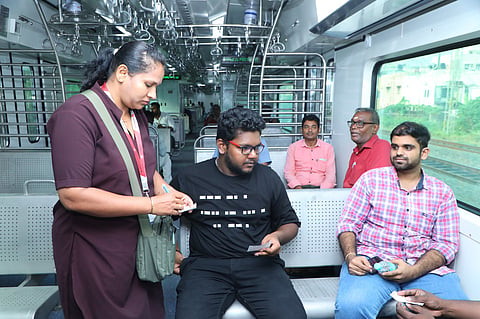

Every day, battling the harsh summer, commuters often wish for a respite. This wish came true in the form of air-conditioned buses first, and then, the metro trains. As an extension of this, Chennai city — one that is connected seamlessly by MRTS and suburban trains — welcomes air-conditioned EMU covering two routes, Chennai Beach to Tambaram, and Chennai Beach to Chengalpattu.
For someone who is used to the comfort and connectivity of the Chennai Metro, this newly introduced train certainly sparked a tinge of curiosity. When I arrived at the Nungambakkam station, a wave of excitement took over, with several questions running through my mind — would it be crowded like other MRTS trains? Will it look the same as the metro?
At this point, a railway policeman asked, “Entha train-ku wait pandringa? (For which train are you waiting?)”. “AC train, sir,” I replied. After a 10-minute wait, the AC MRTS rolled on the tracks with coaches barely filled.
The AC EMU services commenced on April 19, with a total of six services — Chennai Beach-Tambaram (two services) and Chennai Beach-Chengalpattu (four services). Initially, these services ran six days a week, except Sunday. Later, in May, four additional services were introduced to cater for the needs of office-goers and students. Currently, eight services run from Chennai Beach-Tambaram-Chengalpattu on weekdays, and one service runs on weekends. Yet, at first glance, in almost two months, only a few opt for this train.
When asked about the difference between normal EMUs and AC EMUs, a railway engineer, who requested anonymity, shared, “Apart from the air-conditioning, AC EMUs use energy-efficient regenerative Electro-Pneumatic brakes, saving up to 35% of electrical energy compared to the normal EMUs.”
A mixed bag
Though this initiative marks a significant milestone in Chennai suburban rail travel, there has been mixed feedback from commuters. Raman, a visitor from Tirupati, expressed his concerns about the facilities. “The seating should be changed to cushioned ones, and the announcement volume should also be reduced. But, this experience, compared to the local train, is definitely better,” he said. Another regular commuter, Sashank, said that a control panel to adjust the AC temperatures would be a good addition to the EMU.
A visible difference with the AC EMUs is the absence of coaches for vendors and persons with disabilities. This raises the question of inclusivity when the commuters pay six times the normal fare. “General vendors aren’t travelling much in the AC trains, fearing the costs,” said Senthil Kumaran, a junior engineer in the Signals and Telecommunication Department of Southern Railways.
On the lack of disabled-friendly initiatives in the AC EMUs, Aiswarya Rajyalaxmi, director, Better World Shelter, opined, “Having one coach specifically for disabled-friendly in the MRTS, is not a feasible solution. Instead, make the entire train disabled-friendly like height of the train, width of the distance between the train and the platform. When I, as a disabled user, want to go on a train, I want to be able to use it, that is a fair thing to ask.”
Fair fare?
The major drawback seen among the commuters is the significantly higher fare. Devrath, a mechanical engineer who travels on AC EMUs regularly, said that the travel on an AC train is priced higher because the railways provide more comfort in these trains. While a few said that ‘comfort comes at a cost’; others like students and office-goers reveal that higher fares is the reason they prefer normal EMUs over AC EMUs.
Roshna MD, a college student who travels daily from Pattabhiram to Pallavaram in MRTS, said, “The main reason I haven’t travelled in it (AC EMUs) is the cost of the ticket. Even though it’s technically a suburban train, the fare is significantly higher compared to regular EMUs. Most daily travellers rely on affordability, and these trains don’t offer that.”
To this, Sashank added, “I don’t think it’ll be affordable for many for regular use. When I checked online, the season tickets cost around Rs2,000. Since this is a trial run, I think they haven’t fixed the fares, but in the long run, it’ll be good if they reduce the prices.”
Another college student who requested anonymity said that there is a huge difference for a person to pay Rs105 over Rs10 for the same route. “When there is a regular EMU every five minutes, why should one travel in this? If the frequency of the trains and the cost are reduced as well, the AC EMUs may also receive a good response,” he said. “I have been regularly using MRTS trains to travel to my college in Pallavaram. So, local trains are the easiest mode of transport for me. I have not travelled in AC trains, and I would probably not travel because of my college timings (2.30 pm to 6.30 pm) since the AC trains are not available during those hours. But I wish to travel by AC train.”
Normal EMUs operate every day within the interval of six to 15 minutes per train in the Chennai Beach-Tambaram route, while only one AC EMU operates on the route. A Southern Railways authority, said, “The frequency was only recently increased from six services to eight services. As of now, there are no plans on the table to increase the frequency.”
Senthil compared the initial stages of Chennai Metro Rail when the trains and routes were low, just like the AC EMUs today. “If given time, the usage of AC trains will also be normalised,” he said, adding, “During peak hours (between 7.30 am and 10 am), there is a large crowd commuting from Chengalpattu to Chennai Beach, compared to non-peak hours and weekends. Similarly, the evenings see a good response. If there is more response in the peak hours, the frequency will be increased.”
Treating comfort and accessibility as a key to improving the lifestyle of Chennaiites, commuters hope that the transit system’s inclusivity and convenience at ground level is taken into consideration while providing better connectivity across the city.